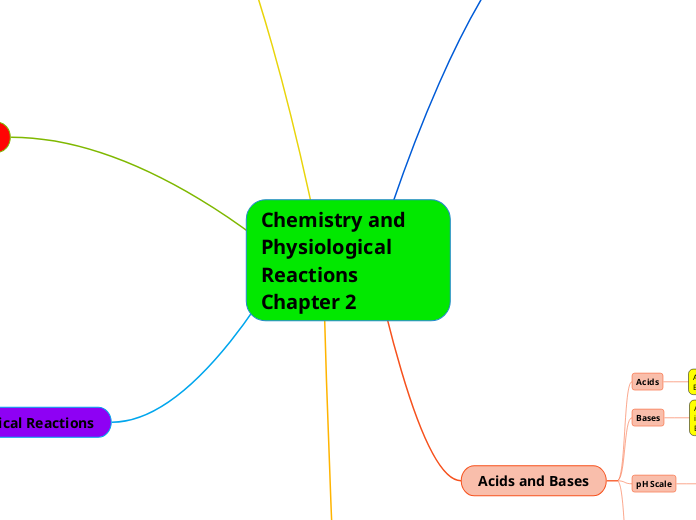Chemistry and Physiological Reactions Chapter 2
Macromolecules
Carbohydrates
Carbohydrates include sugars and starches
Contain C, H, and O
3 Classes
Monosaccharides
one single sugar
Monomers: the smallest unit of carbohydrate
Disaccharides
two sugars
Polysaccharides
many sugars
Lipids
Contain C, H, O and sometimes contain P
Insoluble in water
Many types
Triglycerides
Phospholipids
Steroids
Eicosanoids
Proteins
-Comprise 20–30% of cell mass
Have most varied functions of any molecules
→ Structural, chemical (enzymes), contraction (muscles)
-Contain C, H, O, N, and sometimes S and P
-Polymers of amino acid monomers held together by peptide bonds
-Shape and function due to four structural levels
Shapes of proteins fall into two categories
Fibrous
Strand like , water-insoluble, and stable
Most have tertiary or quaternary structure (3-D)
Provide mechanical support and tensile strength
keratin, elastin, collagen and contractile fibers
Globular
Compact, spherical, water-soluble, and sensitive to environmental changes
Tertiary or quaternary structure (3-D)
Contain specific functional regions (active sites)
antibodies, hormones and enzymes
Enzymes
globular proteins that act as biological catalysts
Catalysts regulate and increase the speed of chemical reactions without getting used up in the process
Lower the energy needed to initiate a chemical reaction
→ This leads to an increase in the speed of a reaction
→ Allows for millions of reactions per minute!
Nucleic Acids
Nucleic acids, composed of C, H, O, N, and P
Nucleic acid polymers are made up of monomers called nucleotides
→ Composed of a nitrogen base, a pentose sugar, and a phosphate group
Two major classes:
Deoxyribonucleic acid (DNA)
holds the genetic blueprint for the synthesis of all proteins
Ribonucleic acid (RNA)
Contains a ribose sugar (not deoxyribose)
Messenger RNA (mRNA), transfer RNA (tRNA), and ribosomal RNA (rRNA)
ATP
The chemical energy released when glucose is broken down is captured in ATP (adenosine triphosphate)
ATP directly powers chemical reactions in cells
→ Offers immediate, usable energy needed by body cells
Structure of ATP
→ Adenine-containing RNA nucleotide with two additional phosphate groups
Acids and Bases
Acids
Are proton donors, they release hydrogen ions
E.g HCl (hydrochloric acid), H2CO3 (carbonic acid)
Bases
Are proton acceptors, they pick up hydrogen ions in solution
E.g HCO3– (bicarbonate ion)
pH Scale
-measurement of the concentration of hydrogen ions [H+] in a solution
-The more hydrogen ions in a solution, the more acidic that solution is
-pH is the negative logarithm of [H+] in moles per liter that ranges from 0–14
-The pH scale is logarithmic, so each pH unit represents a 10-fold difference
Buffers
-Acidity involves only free H+ in solution, not H+ that is bound
-Buffers resist abrupt and large swings in pH
Can release H+ if pH rises
-Can bind H+ if pH falls
-Buffers convert strong acids or bases into a weaker form
-Carbonic acid–bicarbonate system (important buffer system of blood)
Atoms and Elements
All matter is composed of elements Elements are substances that cannot be broken down into simpler substances by ordinary chemical methods
Atoms are composed of three subatomic particles
Protons
→ Carry a positive charge (+)
Neutrons
→ Have no electrical charge (0)
Electrons
→ Carry a negative charge (-)
4 Elements make up our body
Carbon
Oxygen
Hydrogen
Nitrogen
Chemical Bonds
Chemical bonds are “energy relationships” between electrons of exacting atoms
Electrons are the subatomic particles that determine what type of chemical bond is formed
Three Types of Chemical Bonds
Ionic Bonds
Ionic bonds involve the transfer of valence shell electrons from one atom to another, resulting in ions
One becomes an anion (negative charge)
→ An atom that gained one or more electrons One becomes a cation (positive charge)
→ An atom that lost one or more electrons
The attraction of opposite charges results in an ionic bond
Covalent Bonds
Covalent bonds are formed by sharing of two or more valence shell electrons between two atoms
Sharing of 2 electrons results in a single bond
Sharing of 4 electrons is a double bond
Sharing of 6 electrons is a triple bond
→ Allows each atom to fill its valence shell at least part of the time
Polar Covalent
Nonpolar Covalent
Hydrogen Bonds
The attractive force between electropositive hydrogen of one molecule and an electronegative atom of another molecule
Common between dipoles such as water
Also act as intramolecular bonds, holding a large molecule in a three-dimensional shape (eg DNA)
Chemical Reactions
Chemical reactions occur when chemical bonds are formed, rearranged, or broken
These reactions can be written in symbolic forms called chemical equations
Reactants
Substances entering into a reaction together
Products
Resulting chemical end products
Synthesis Reaction
Smaller particles are bonded together to form larger, more complex molecules
Amino Acids
Decomposition Reaction
Bonds are broken in larger molecules, resulting in smaller, less complex molecules
Glycogen
Exchange Reactions
Bonds are both made and broken (also called displacement reactions)
ATP
Biochemistry
Biochemistry is the study of chemical composition and reactions of living matter
All chemicals either organic or inorganic
Inorganic compounds
water, salts, and many acids and bases
Do not contain carbon
Water
Most abundant inorganic compound
Accounts for 60%–80% of the volume of living cells
Salts
Ionic compounds that dissociate into separate ions in water
-Separate into cations (positively charged molecules) and anions (negatively charged)
-All ions are called electrolytes because they can conduct electrical currents in a solution
-Ions play specialized roles in body functions
Example: sodium, potassium, calcium, and iron
Common salts in the body
NaCl, CaCO3, KCl, calcium phosphates
Organic compounds
Organic molecules contain carbon
Carbon shares electrons and form four covalent bonds with other elements
Carbs, fats, proteins, and nucleic acids
Contain carbon, are usually large, and are covalently bonded
Many Polymers are made up of similar units called monomers (building blocks )
Synthesized by dehydration synthesis
Broken down by hydrolysis reaction
